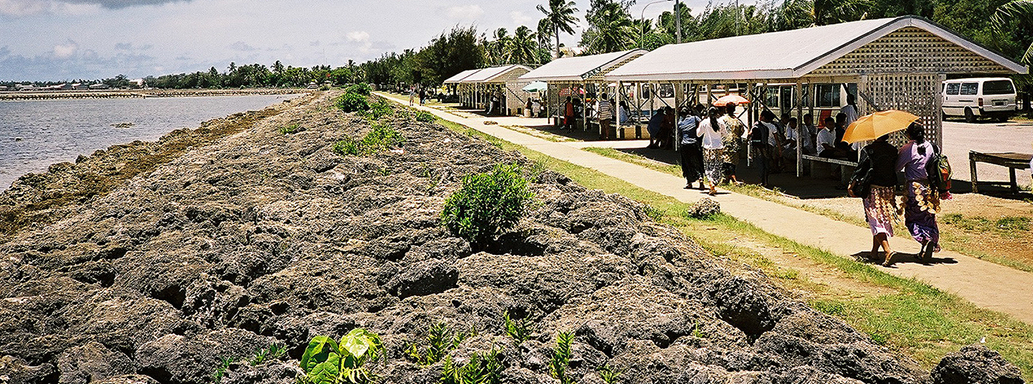Science shows climate change impact in the Pacific
Ilan Kelman, University College London, UK and University of Agder, Norway
Article
We often read in the media, and sometimes in scientific journals that Pacific islands are sinking and disappearing due to climate change; an immense threat to our security. Concerns and fear about ‘climate change refugees’ overwhelm us, as do visions of communities slipping below the waves. However, science provides a different picture and tackles the mantra of drowning islands from both physical science and social science perspectives.
Physical science observations of low-lying islands under observable sea-level rise show some islands eroding, some islands changing longitudinally, some islands accreting and some islands changing little. The conclusion is twofold. First, some islands might be inundated or eroded but they are not sinking. Second, islands are not inevitably going to disappear due to climate change.
Climate change impacts vary and emerge along multiple pathways. Tropical cyclones appear to be decreasing in frequency and increasing in intensity due to climate change. Storms have previously caused major changes to islands, ruining some while building up others. On 21 October 1972, when Tuvalu was the Ellice Islands, Cyclone Bebe inundated and damaged Funafuti. It also created a coral rubble wall that was larger than some other islets around the atoll. Even if islands gain territory under sea-level rise, such rapid geomorphological change would make living there difficult.
Coral reefs protect island communities from the ocean’s full power but they bleach and die under elevated sea surface temperatures. If climate change causes high coral mortality without recovery, then low-lying islands could be exposed to the full force of Pacific Ocean currents and waves.
Simultaneously, the seas absorb carbon dioxide from the atmosphere and it combines with water to produce carbonic acid; increasing the ocean’s acidity. Ocean acidification could further harm reefs and shorelines, although many unknowns remain regarding its biochemical and geochemical consequences.
The social science is as complex as the physical science. The clearest message is from the islanders themselves. They do not wish to be labelled as hopeless, hapless refugees fleeing their homes without recourse. If their communities are destroyed by climate change effects, which is not a definite outcome, and if they choose to move, which is also not definite, then quite rightly, they wish to control the migration process, not be told what to do and when.
Pacific islanders request resources so they can understand and make decisions in their own way about future climate change effects. Migration is indeed one possibility. Then decisions must be made about the destination location and what level of autonomy or sovereignty to retain. Solutions also exist for staying in place. Suggestions include building up the islands to avoid inundation alongside settlements floating above (and perhaps anchored to) islands that the sea rises above.
Any option entails unavoidable, major changes to island lifestyle and culture. Not all islanders wish to see these transformations, preferring instead to stay in their familiar home and environment. The moral dilemma then emerges regarding whether or not people should be permitted to pass away on their own terms.
These questions—physical, social, legal and ethical—are not new. Pacific islanders have been dealing with significant social and environmental changes over centuries; from Christianity, tinned food and the internet, to previous climatic and oceanic changes. Throughout history volcanic eruptions have led to island evacuations without inhabitants knowing whether or not return would be feasible (e.g. Manam Island, Papua New Guinea and Niua Fo’ou, Tonga). Indeed, colonial powers have a scandalous record of forcibly resettling Pacific islanders for nuclear testing.

People may need to move from low-lying areas of the Pacific due to the impacts of climate change, such as Nuku’alofa, the capital of the Kingdom of Tonga. Image: Ilan Kelman
Given the rich history and deep experience of Pacific peoples moving for multiple reasons, climate change can learn plenty from other fields. Disaster and development studies are especially relevant. Human responses to the changing environment—often with catastrophic potential for communities—are exactly what disaster research has examined for decades; from rapid-onset events such as tsunamis to slowly developing cycles such as El Niño.
Climate change is one more impact on islanders that needs addressing. It sits beside other environmental changes, human-influenced and entirely natural, that islanders experience. Climate change adaptation thus becomes a subset of disaster risk reduction in terms of redressing vulnerabilities to all possible environmental and non-environmental changes, trends and shifts. In effect, development is enacted, aiming to ensure safe and healthy homes and livelihoods within the gamut of situations affecting Pacific island communities.
Contemporary climate change is one major challenge among many, being highly disruptive and being imposed on Pacific islanders from the outside. But its consequences are not inevitable and it must be handled within all the other major challenges and opportunities, on Pacific islanders’ own terms with the external support and resources they request.
|
For research papers related to this article, visit www.islandvulnerability.org/docs/islandsclimatechange.pdf |


